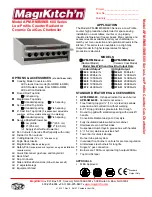
ENERGY TOP B
72
EN
Turning the boiler off
Press the button
eco/comfort
(detail 7 - fig. 1) for 5 seconds.
fig. 5 - Turning the boiler off
When the boiler is turned off, the PCB is still powered.
Domestic hot water (with optional hot water tank installed) and heating operation are dis-
abled. The antifreeze system remains activated.
To relight the boiler, press the button
eco/comfort
(detail 7 - fig. 1) again for 5 seconds.
fig. 6
The boiler will be immediately ready to operate whenever domestic hot water is drawn
(with optional hot water tank installed) or in case of a room thermostat demand.
To completely disconnect the power to the unit, press the button (detail 14 - fig. 1).
B
The antifreeze system does not work when the power and/or gas to the unit are
turned off. To avoid damage caused by freezing during long idle periods in win-
ter, it is advisable to drain all water from the boiler, DHW circuit and system; or
drain just the DHW circuit and add a suitable antifreeze to the heating system,
complying with that prescribed in sec. 3.3.
2.4 Adjustments
Summer/Winter Switchover
Press the button
(detail 6 - fig. 1) for 1 second.
fig. 7
The display activates the Summer symbol detail 10 - fig. 1. The heating function is deac-
tivated, whereas the possible production of domestic hot water (with optional external hot
water tank) remains activated. The antifreeze system remains activated.
To deactivate Summer mode, press the button
(detail 6 - fig. 1) again for 1 second.
Heating temperature adjustment
Use the heating buttons
+/-
(details 3 and 4 - fig. 1) to adjust the temperature from a min.
of 20°C to a max. of 90°C.
fig. 8
DHW temperature adjustment (with optional hot water tank installed)
Use the
DHW buttons
(details 1 and 2 - fig. 1) to adjust the temperature from a min. of
10°C to a max. of 65°C.
fig. 9
Room temperature adjustment (with optional room thermostat)
Using the room thermostat, set the temperature required in the rooms.
Room temperature adjustment (with optional remote timer control)
Using the remote timer control, set the temperature desired in the rooms. The boiler unit
will set the system water according to the required room temperature. For information on
the remote timer control, please refer to its user's manual.
Sliding temperature
When the optional external probe is installed the corresponding symbol (detail 22 - fig. 1)
is activated on the control panel display (detail 5 - fig. 1). The boiler control system works
with "Sliding Temperature". In this mode, the heating system temperature is controlled
according to the outside weather conditions in order to ensure high comfort and energy
saving throughout the year. In particular, as the outside temperature increases, the sys-
tem delivery temperature is decreased according to a specific "compensation curve".
With Sliding Temperature adjustment, the temperature set with the heating buttons
(details
3 and 4 - fig. 1) becomes the maximum system delivery temperature. It is advis-
able to set a maximum value to allow system adjustment throughout its useful operating
range.
The boiler must be adjusted at the time of installation by qualified personnel. Adjust-
ments can in any case be made by the user to improve comfort .
Compensation curve and curve offset
Press the
reset
button (detail 8 - fig. 1) for 5 seconds, to display the actual compensation
curve (fig. 10) which can be modified with the
DHW buttons
(details 1 and 2 - fig. 1).
Adjust the required curve from 1 to 10 according to the characteristic (fig. 12).
By setting the curve to 0, sliding temperature adjustment is disabled.
fig. 10 - Compensation curve
Press the
heating buttons
(details 3 and 4 - fig. 1) to access parallel curve offset
(fig. 13), modifiable with the
DHW buttons
(details 1 and 2 - fig. 1).
fig. 11 - Curve parallel offset
Press the
reset
button (detail 8 - fig. 1) again for 5 seconds to exit parallel curve adjust-
ment mode.
If the room temperature is lower than the required value, it is advisable to set a higher
order curve and vice versa. Proceed by increasing or decreasing in steps of one and
check the result in the room.
fig. 12 - Compensation curves
fig. 13 - Example of compensation parallel curve offset
reset
eco
comfort
reset
eco
comfort
reset
eco
comfort
reset
eco
comfort
IIIIIIIIIIIIIII
IIIIIIIII
IIII
IIIII
I
reset
eco
comfort
IIIIIIIIIIIIIII
||||
||||||
||||
|||
||
reset
eco
comfort
IIIIIII
IIIII
III
IIII
IIIIIIIIIIII
reset
eco
comfort
IIIIIII
IIIII
IIIII
IIII
IIIIIIIIIIIII
20
30
40
50
60
70
80
90
85
20
10
0
-10
-20
1
2
3
4
5
6
8
9
10
7
20
30
40
50
60
70
80
90
85
20
30
40
50
60
70
80
90
85
1
2
3
4
5
6
8
9
10
7
1
2
3
4
5
6
8
9
10
7
OFFSET = 20
OFFSET = 40
cod. 3541H060 - Rev. 02 - 04/2018
















































